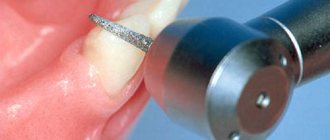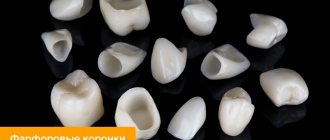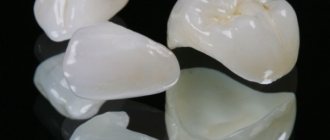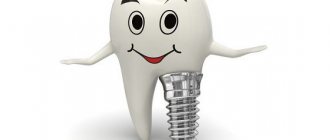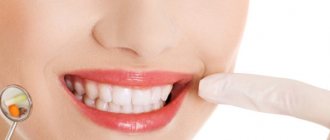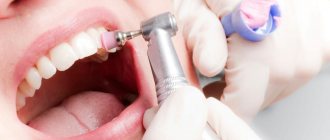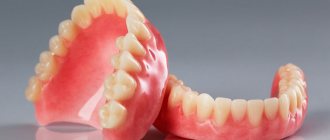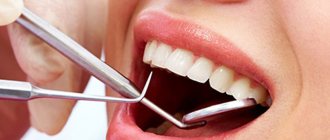2740
Preparation is a dental procedure that is based on grinding down a damaged tooth.
A manipulation is carried out to create additional space, which will then be used for the installation of an orthopedic structure.
Grinding is a mandatory procedure, without which it is impossible to properly fix the prosthetic structure.
The essence and purpose of the procedure
During turning, the surface layer of enamel is removed using special equipment equipped with high-speed burs with diamond tips.
Only with an ideally processed dental surface will the installation of the prosthesis be accurate and tight, which, in turn, will allow further avoidance of its rejection or the development of complications.
During preparation, the tooth is prepared for its further restoration. It takes on a cone-shaped shape (which simplifies the placement of the product), the remains of the carious cavity and old fillings are eliminated.
The procedure is considered by patients to be one of the most unpleasant in dentistry, so many of them do not decide to undergo prosthetics and end up losing their teeth.
But today, preparation technology has changed somewhat. The advent of new devices has made it possible to improve the technique, so there is virtually no pain or discomfort.
In addition, local anesthetics are used, which reduce the level of human sensitivity.
Preparation for a metal-ceramic crown
Preparation for a metal-ceramic crown is perhaps the most important stage in creating the finished structure.
No matter how master of his craft the technician is; the extent to which the dental laboratory lacked modern materials and technologies; everything will be in vain if the doctor forms the stump not according to the standard. When preparing for metal-ceramics, quite a lot needs to be removed (especially compared to a stamped crown): 0.4-0.6 mm for the metal layer and 0.8-1.3 for the veneer. The opinions of the authors vary more or less within the indicated ranges. Some doctors believe that a tooth with living pulp must be depulped, since inflammation will occur sooner or later. Others adhere to the rule of preserving living tissue.
In order to avoid injury or burn to the pulp, it is necessary to retreat 1 mm from the nervous tissue (therefore, knowledge of anatomy and wall thickness is important). It is imperative to work with a water-cooled handpiece, carefully, interrupting as you work. First, the stages of preparing a tooth for a metal-ceramic crown will be listed briefly, and below a detailed description of each of them will be given.
Indications
The procedure is required in almost all cases when restoration is carried out in the oral cavity, namely:
- To restore or replace worn-out filling material;
- When reconstructing a dental element after a fracture;
- To correct a congenital defect of the coronal part;
- When installing veneers, crowns, etc.;
- To carry out other restoration activities as one of its stages.
Preparation is also necessary if caries is discovered during the removal of the enamel layer.
In this case, to prevent the spread of pathogenic microorganisms to neighboring units, carious tissue and infected dentin are removed.
Rules for the use of glass ionomer cement for fixation of crowns and bridges, composition and properties of the material.
Come here if you are interested in reviews about ceramic inlays for teeth.
At this address https://www.vash-dentist.ru/protezirovanie/nesemnyie-p/koronki-np/nuzhno-znat-o-titanovyih.html together we will calculate the price of titanium crowns for teeth.
Does it hurt to put a crown and how to put a crown on a tooth in dentistry
From this article you will learn:
- does it hurt to put a crown,
- stages of prosthetics,
- how much does it cost to put crowns on teeth – prices 2021.
Making and installing a crown on a tooth is a complex procedure consisting of many stages. In this article we will talk about many subtle points that affect the aesthetics and service life of your crowns. These points relate to both mistakes when choosing the type of crowns by the patient himself, and mistakes made en masse by dentists at the stages of their manufacture.
For example, most of the complaints from patients about the quality of prosthetics relate mainly to 2 things. Firstly, poor aesthetics, and the fact that the crowns stand out against the background of neighboring teeth. Secondly, the quality of therapeutic preparation of teeth for crowns. The latter leads to complications - pain, suppuration, the need for re-treatment and even tooth extraction.
Does it hurt to insert teeth?
Typically, patients are interested not only in how a crown is placed on a tooth, but also how painful it is. The most unpleasant stages here, of course, are preparing teeth for prosthetics (i.e.
their treatment, root canal filling), and sometimes also the process of taking impressions. If already dead teeth are used for crowns, then turning them is completely painless and does not even require anesthesia.
If living teeth are ground down, a local anesthetic is first injected.
The only painful moment that I myself (being a dentist) have personally experienced is when, when taking an impression, the doctor performs gum retraction.
Retraction refers to the widening and deepening of the gingival sulcus, which is accompanied by a small degree of separation of the soft gum tissue from the tooth.
This is done in order to make a more accurate impression of the neck of the tooth, and it is better to do this immediately under anesthesia.
How is a crown installed on a tooth?
If you decide to put a crown on a tooth, then it will be useful for you to know what stages of this process you will have to deal with. In the process of placing a crown on a tooth in dental clinics, the following stages can be distinguished...
Initial consultation with an orthopedist (prosthetist) −
During the initial consultation, the doctor, assessing the condition of the teeth externally and using x-rays, must offer possible prosthetic options, and the patient, accordingly, must approve one of the options. Based on this, a treatment plan is drawn up, which may take into account -
- removal of non-viable teeth,
- preparing teeth for crowns (filling, depulping),
- choice of the type of crowns, for bridges - the number of supporting teeth, etc.
- The cost of making crowns and treatment in general is calculated, the deadline for prosthetics is determined, after which the patient must sign a treatment plan and a contract for the provision of services.
Important: at this stage the patient must choose one of the types of artificial crowns offered to him. Choosing the type of crown is not easy for the average patient, and there are a lot of pitfalls that the dentist will never tell you about. Articles to help you choose -
→ Pros and cons of metal-ceramic crowns → How to choose crowns for front teeth
Preparing teeth for prosthetics −
In some cases, crowns can be placed on living teeth. This is preferable because dead teeth are more fragile, and therefore, if the teeth are left alive, this has a positive effect on the service life of the crowns.
In what cases can teeth be left alive? As a rule, we are talking about large chewing teeth.
This is due to the fact that large teeth have a greater distance from the surface of the enamel to the pulp of the tooth (than single-rooted teeth) and, therefore, the risk of thermal burn of the pulp when grinding the tooth for a crown will be much lower.
Moreover, under crowns made of metal-free ceramics, even the majority of single-rooted teeth can be left alive. This is due to the fact that under ceramics the tooth is ground down by 1.0 from the side surfaces, and under metal-ceramics – on the same surfaces by 2.0 mm. Therefore, metal-free ceramics also allows you to increase the service life of the tooth itself under the crown.
When using metal-ceramic prosthetics for single-rooted teeth, the nerve is almost always removed. If this is not done, then turning such a tooth can lead to a thermal burn of the dental pulp, i.e. neurovascular bundle.
In this case, after some time, its inflammation will develop, and the crown will then have to be removed and the tooth re-treated.
If the tooth under the crown is destroyed by a carious process (there is pulpitis or periodontitis), then planned depulpation of the tooth and treatment of inflammation at the apex of the root are required.
When depulping a tooth, it is carried out -
- removal of a nerve from a tooth,
- instrumental treatment and expansion of root canals (Fig. 2),
- the canals are filled with gutta-percha (Fig. 3),
- after which a filling is placed on the crown part of the tooth (Fig. 4).
Important: if the crown part of the tooth is destroyed by 1/2 or more, the tooth must be strengthened with a pin fixed in the root canal (otherwise the crown can easily fall out along with the filling). There are 2 main methods for restoring severely damaged teeth.
What is the best way to restore a badly damaged tooth? –
- The first option (Fig. 5) – patients also call it a crown with a pin or a crown on a pin. This is when a pin is screwed into an already filled root canal, and then, based on it, the crown part of the tooth is restored using filling material. Only after such restoration is the tooth ground down for a crown.
- The second option (Fig. 6-8) – the crown part of the tooth is restored using a stump inlay. Such an inlay is cast from metal in a dental laboratory and consists of a root part (which is fixed in the canal) and a crown part, which has the shape of a tooth that has already been ground for a crown. This method provides greater reliability, strength and longer service life of the crown. Manufacturing of a core inlay for a crown -
Preparation of teeth for crowns −
In common parlance - grinding teeth. The preparation process is carried out by an orthopedic surgeon, who (using a drill and a set of diamond burs) gives the tooth a certain shape.
Preparation is a painful process if living teeth are ground down. In this case, local anesthesia is required.
When dead teeth are ground down, anesthesia is given only if the doctor needs to strongly press the gum away from the tooth during preparation.
The tooth tissue is ground down by the doctor to the thickness of the future crown (Fig. 9-11). Crowns made of metal-free ceramics (for example, zirconium dioxide or glass ceramics E.
max) require less grinding of tooth tissue - approximately from 1.0 to 1.5 mm on different tooth surfaces. But under metal-ceramics, the teeth are ground down on all sides by 1.5-2.5 mm - as a result of which almost nothing remains of the tooth.
As a result of preparation, the tooth crown takes on the appearance of a “stump”.
Tooth preparation for metal ceramics –
Important: high-quality tooth preparation for a crown is a very complex and time-consuming process. The most difficult thing here is to create a ledge in the gingival part of the tooth crown.
The reliability and service life of your crown largely depends on the correct formation of the ledge. It must be admitted that most doctors make a lot of mistakes at this stage.
How the ledge is formed is clearly shown in the video below.
Grinding front teeth for crowns: video
Taking impressions, making plaster models of teeth –
Impressions are taken from the ground teeth using special impression compounds (Fig. 12). Subsequently, based on these casts, plaster copies of your teeth are created in a dental laboratory (Fig. 13). Such plaster models depict the patient’s teeth with very high accuracy, including those ground for crowns, and it is from such models that they are manufactured.
Techniques
Not long ago, a special drill was used to treat problem units. Today, grinding technology has improved significantly.
Several new techniques have been developed that have made the manipulation more comfortable, as painless and safe as possible:
Ultrasonic
Grinding occurs using ultrasonic waves , which are emitted by a high-precision device. The advantages of the procedure include:
- absence of negative feelings;
- minimal risk of damage to hard tissues;
- pulp safety;
- painlessness;
- no heating of dentin and enamel.
Laser
This technique is based on the process of heating water in dental tissues using a pulsed laser. Its effect allows you to easily remove the affected areas with an air-water flow.
The advantages are considered to be high precision of processing, silent operation of the device, absence of damage and heating of tissues.
Disadvantages - there is a minimal risk of infection, the technique can only be used for surface treatment.
Air abrasive
Here, instead of a drill, a mixture of abrasive substance and air is used , supplied under pressure. This force is enough to remove the required amount of enamel and dentin.
The advantages of the technique are:
- safety;
- speed of manipulation;
- minimal heating of tissues;
- processing accuracy;
- no vibration;
- preservation of the maximum volume of healthy tissue;
- painlessness.
But at the same time, air abrasive grinding cannot be used as an independent technique due to the fact that it can only act on surface layers.
Can be used in combination with other methods of preparing teeth for prosthetics.
Chemical
Preparation involves the use of chemically active substances (for example, acids), which, through their action, soften the desired area of enamel.
The positive aspects of the technique are painlessness, safety for healthy tissues, and the absence of heating.
The only drawback is the length of the process (on average, it takes about 30 minutes to process one unit).
Tunnel
This technique is the most common due to its ease of implementation and the ability to accurately control the thickness of the surface being removed.
It is carried out using a special diamond tip (or metal) with high rotational ability.
The only advantage of tunnel preparation is the high precision of processing.
The method has significantly more disadvantages:
- strong heating of the enamel;
- need for pain relief;
- high probability of tissue damage;
- there is a risk of infection.
It is impossible to single out the best method from the entire list. All of them are selected individually for each patient , based on the condition of the oral cavity, examination results, and in accordance with the specific type of defect.
Types of ledges
A ledge is the part of hard tissue remaining after preparation on which the future prosthetic structure is planned to be secured. There are three varieties of it:
- Rounded . Used under metal-ceramic prosthesis. Allows you to preserve the maximum amount of hard tissue. Thickness varies from 0.8 to 1.3 mm.
- Knife-shaped. Designed for solid metal crowns. Ideal for turning inclined pieces. The width ranges from 0.3 to 0.5 mm.
- Brachial. It is the most reliable and durable when securing orthopedic products, but is uneconomical in terms of removing a large volume of tissue. The width is about 2 mm. Requires removal of the nerve from the tooth (depulpation).
If you do not create a ledge before prosthetics, the quality of the fit of the prosthesis will decrease significantly. This circumstance complicates oral care and increases the likelihood of developing recurrent caries.
What is tooth preparation
As part of the procedure, the specialist grinds down the hard tissues of the tooth in order to achieve a flat and smooth surface suitable for fixing a crown or orthopedic structure. Only the tightest possible contact between living and artificial tissue provides reliable protection of the enamel from injury, and also guarantees the strength of the product’s fixation.
In addition, the tooth is given a certain shape that exactly replicates the internal cavity of the crown. This allows you to fix the prosthesis more tightly and accurately.
Tooth preparation
If earlier this procedure was quite lengthy and quite painful, now before it is performed the patient is given an injection with an effective local anesthetic. Modern methods of pain relief guarantee absolute painlessness and a high level of comfort for the patient.
Turning methods
- tunnel turning: the classic use of a drill using a metal or diamond tip. The device operates in various speed modes, but at very high speeds, so to prevent overheating of the tissues, a stream of cold water must be supplied. The technique allows grinding down any amount of living tooth tissue,
- ultrasound: this method involves the use of a special device that transmits high-frequency vibrations. In this case, the instrument does not come into direct contact with the enamel, thereby reducing the risk of injury to dentin and nerves. The procedure is completely painless and safe, but allows for the preparation of only a small amount of dental tissue,
- laser: the procedure does not pose any threat to health and allows you to achieve the desired result in the shortest possible time. This method refers to non-contact methods of grinding teeth, so the risk of damage to the pulp is minimized. True, it is also used when removing small amounts of dental tissue,
- air-abrasive preparation technique: the method involves exposure to water with a mixture of abrasive particles, as a result of which hard tissue is ground down to the desired shape and size. In this case, the patient does not experience pain. This method allows you to preserve as much healthy tissue as possible, and also eliminate the risk of chips and cracks after turning,
- chemical method: here they use acids that can quickly and reliably destroy hard tissue. After exposure to the composition, the specialist removes the softened areas and creates the desired shape. This is a rather lengthy procedure, and also very outdated.
When is the preparation performed?
Currently, there are several main types of dental preparation, depending on the type of structure that is planned to be installed to restore the aesthetics and functionality of the dentition:
- veneers: surface treatment for veneers is carried out using a special technology. At the first stage, the specialist works on the front side, after which he gradually moves on to the side surfaces. Only in rare cases is it necessary to prepare the anterior teeth in the palatal area or the incisal edge. As a rule, horizontal and vertical groove stripes are created on the enamel, in which dental glue will be located,
- inlays: partial dentures that are used to hide minor defects. In order to securely fix such a product, the side walls are prepared parallel to each other1. This form makes it possible to easily and quickly install the structure at the required depth,
- crowns and bridges: a crown is an artificial top that protects the tooth from the development of carious lesions, prevents infection of weakened tissues, and also allows you to restore aesthetics to your smile and restore full functionality. Grinding is required for metal-ceramic crowns, cast metal, porcelain, zirconium, ceramic and plastic solutions, as well as for bridges, except for adhesive bridges - their installation does not require additional grinding of some tissues,
- splinting: this procedure involves fixing mobile teeth in the correct position using pin, beam or inlay splints. In this case, it is necessary to remove a minimum amount of enamel, but in some situations depulpation may also be required.
“Relatively recently, I went through all the stages of installing metal-ceramic crowns, including preparation. During the procedure I did not feel any pain at all. The doctor gave an injection of anesthesia in advance, so everything went well.
But the sensations themselves are of course very unpleasant, and then there’s this terrible roar of the boron! I still don’t know whether this was a medical error, but after grinding my dead tooth suddenly turned pink! In general, I was given temporary crowns first, and then metal-ceramics.
I really hope they last a long time!”
Marina, 47 years old, from correspondence on a thematic forum
Complications and pain after turning
If the quality of the procedure is poor, there is a risk that the patient’s tooth cavity will subsequently open.
Even if the preparation was carried out as carefully as possible, the pulp is in any case subjected to a certain impact, as a result of which the vessels dilate and swelling occurs.
Immediately after grinding, no pain is felt, however, when the effect of the painkiller wears off, discomfort appears and the gums become inflamed.
According to practicing experts in the field of prosthetics, if a vital tooth was subjected to preparation, that is, with the pulp not removed, above which only a thin layer of dentin remained, then after turning the tooth will react to the cold and cause some discomfort. Therefore, specialists resort to temporary structures or cement the worn-out area until a permanent solution is installed.
Sometimes during the procedure, the doctor has to slightly push back the gums using a special thread, which entails compression of the soft tissues and provokes the development of swelling and pain.
What to do if your gums hurt after grinding? As a rule, the discomfort goes away on its own after a few days. In this case, the doctor can immediately suggest the best way to rinse your teeth after grinding in order to relieve acute symptoms.
If quite a lot of time has passed after the procedure, but your teeth still hurt, you should seek help from a specialist.
Pushing back gums with floss
Types of ledges
Grinding of teeth is carried out strictly according to certain rules, with short breaks (to prevent tissue overheating). Immediately after the procedure, temporary crowns or fillings are installed on the treated living teeth. During the preparation process, a specialist can form the following types of ledges:
- knife-shaped: the widest of all, therefore suitable for crowns that have a thick layer of tissue, namely all-metal or metal-ceramic crowns,
- grooved: the rounded shape in this case makes it possible to preserve the maximum volume of living tissue. The width can vary from 0.8 to 1.2 mm. This option is ideal for metal ceramics,
- humeral: this type of ledge with a width of 2 mm requires depulpation. However, this option can significantly increase the strength of the crown fixation and provide higher aesthetic characteristics2.
Features of the procedure in childhood
When working with baby teeth, dentists try to avoid unnecessary procedures that may pose a certain threat to the condition of the child’s thin enamel. In addition, any additional manipulation using a noisy drill usually results in serious stress for the child.
As a rule, experts offer alternative and more gentle treatment methods that do not require preliminary preparation.
In this case, pediatric dentistry is focused on protecting the not yet fully formed enamel from any type of injury. However, there are situations when turning for a crown is indispensable.
Most often, preference is given to the chemical method, as it is less painful. Usually it is enough to remove only the tissue affected by caries.
Without turning - alternative methods of prosthetics
- removable prosthetics: the most cost-effective and fastest option for restoring the integrity of the dentition. In this case, the structure can be fixed using a special fastening system on the supporting teeth or even in the absence of all of them in the oral cavity. In this case, no turning of supporting elements is required,
- conditionally removable prosthetics: in this case, tooth roots are used to fix the system, which must be in excellent condition. During the installation of the prosthesis, they are strengthened using special pins with a small lock. When installing the prosthesis, the lock automatically snaps into place and the system is securely held in the mouth,
Clasp dentures with locks - adhesive bridge: to fix such a structure, the presence of two supporting elements is necessary, but they are not subject to preparation. Along the edges of one or more artificial crowns there are special plates that allow you to fix the system by attaching it from the inside using dental glue,
- implantation: this treatment method involves replacing not only the crown, but also the root, which allows you to restore the anatomy and return the full functionality of the entire dental system. In this case, the implant, which acts as a root, is installed inside the bone tissue, and then a crown or any other orthopedic structure is put on it.
Tactics
The entire grinding process can be divided into two stages:
- Elementary. The dentist determines the amount of tissue to be removed (for this he makes grooves - special notches).
Be sure to clean the tooth of damaged enamel and dentin, and remove “extra” tissue from the lateral convex surfaces. Such actions allow you to create the optimal size of the unit and give it the desired shape. - Final. Includes removal of carious areas (if any) and “old” fillings, pulp protection, as well as final treatment of the tooth cavity and walls.
At the end of all manipulations, the doctor evaluates the quality of the turning and the degree of sealing before applying the composite.
What modern dentistry offers for increased wear of hard dental tissues, and how effective the treatment is.
In this publication, we will discuss how to prevent metal allergies from occurring in dentistry.
Here https://www.vash-dentist.ru/protezirovanie/nesemnyie-p/ottisknyih-materialov-ortopedicheskoy-stomatologii.html we suggest you familiarize yourself with the classification of impression materials in dentistry.
Some nuances
Each orthopedic product has its own rules and requirements for its installation. Depending on the type of prosthesis, the preparation stages differ.
Under the crown
When it is planned to install a solid cast structure, grinding begins from the side surfaces to avoid damage to adjacent units.
For metal-ceramic crowns, about 2 mm of enamel is removed from the sides of the tooth, and a ledge is created that matches the type of product selected. To ensure a tight fit, the enamel is not polished, but is left slightly rough.
When a porcelain crown is installed, the tooth is ground down to a cylinder or cone shape, however, the ledge must be 0.1 cm into the gum.
If the prosthesis is made of zirconium, the ledge is formed with clear boundaries of a round or shoulder-shaped shape.
In the video, watch the process of preparation with a ledge for installing a crown.
Under veneer
Since a veneer is an overlay on the outer side of a tooth, when turning, special attention is given to the front surface
.
The sides are processed in two ways:
- leaving contact between teeth;
- with output to the inner side of the ledge boundaries.
Another point is that if the veneer is made of ceramic, the preparation is carried out to the gum. If a composite is used, no preparation is carried out (the layer is left slightly rough to improve adhesion to the material).
For tab
An inlay is a partial prosthesis, so when grinding it is important to make the side walls parallel and maintain the dimensions of the corners. Compliance with these conditions will ensure tight insertion and reliable fixation of the insert in the cavity.
Important! To eliminate the likelihood of developing repeated caries, the cavity of the tooth being restored is slightly expanded.
Under a prosthesis
In this case, preparation is carried out with the aim of shortening the prosthetic elements. During treatment, all thin and sharp walls, dentin and enamel protrusions are removed. The best option is to give the cavity an oval shape.
Under special circumstances, the pulp is first removed.
When splinting
Splinting is a procedure that secures units in a row and prevents their further loosening. The procedure involves minimal grinding of the enamel.
Typically, dentists adhere to the technique used when installing metal-ceramic crowns.
Some rules
Each orthopedic design has its own installation requirements. The stages of preparation also differ; let’s look at this in more detail.
Under the crown
In this case, the tooth surface is polished and about 2 mm of enamel and dentin are removed. This is a rather painful procedure that requires the use of anesthesia .
When using metal-ceramic crowns, preliminary removal of the dental nerve is required. If a patient has a porcelain crown installed, the shape of the ground tooth should be in the shape of a cone or cylinder.
Depending on the type of crown being installed, the doctor selects the necessary preparation method.
The video shows the stages of crown and bridge preparation.
Under veneer
In this case, it all depends on what material the veneers will be used from. In the case of ceramics, preparation is carried out to the gum.
If the composite is applied directly to the tooth, then the outer surface is not prepared at all . In this case, the enamel is slightly roughened to improve adhesion to the veneer.
For tab
The main feature of this type of turning is making the side walls parallel, this ensures the best insertion of the product.
To reduce the risk of developing secondary caries, the dental cavity is slightly expanded.
When preparing a complex cavity, retainers must be installed to prevent movement of the dentition. The area for the inlay should be deep into the dentin.
Under a prosthesis
In this case, preparation is carried out to level the occlusal surface of the teeth by shortening them. This procedure in some cases requires preliminary removal of the pulp.
During cleaning, the doctor removes all sharp and thin walls of the tooth, protrusions of enamel and dentin. It is considered optimal to give the cavity walls an oval shape. .
For elderly patients, preparation becomes more complicated due to the fact that their pulp takes on a thread-like shape, and the amount of dentin increases several times.
When splinting
In this case, the preparation method is selected based on the selected type of structure for splinting.
Most often, doctors adhere to the technique used in the case of installing metal-ceramic crowns.
Answers to frequently asked questions
Since the term “dissection” is not widely used among patients, many of them are keenly interested in information regarding this procedure itself.
- What layer of fabric is removed? The amount of grinding depends on the type of structure being installed, the characteristics of the tooth surface and its original volume.
Usually no more than 2 mm of hard tissue is removed. But this volume depends on the type of prosthesis being installed. So, before placing the inlays, only 0.5 mm is ground on each side. - How much does it hurt ? Modern technologies allow the procedure to be performed absolutely painlessly. When processing “live” units, local anesthesia is administered.
- How long does the process take? The duration of the process depends on the technique chosen by the doctor. On average, processing takes from half an hour to 2 hours.
- Is it possible to do prosthetics without preparation? Unfortunately, it is impossible to fix the product in a high-quality manner without grinding. If this manipulation is skipped, a person may face a number of negative consequences in the future.
- Can this be done for children ? This procedure has no restrictions regarding the patient's age. Children usually undergo chemical preparation.
- Why do my teeth and gums hurt, and what can be done ?
The cause of pain may be too deep grinding, as a result of which the dentist left a very thin tissue layer, and the nerves in the pulp react quite painfully when eating hot/cold foods. Another common cause of pain after turning is inflammation. In any case, the manifestation of this symptom is a reason to immediately seek medical help.
Does it hurt to put crowns on your teeth?
Almost all patients faced with the need to install a crown are interested in the question of whether the process of prosthetics involves pain and other discomfort. Unfortunately, almost all dental procedures are quite painful, so most of them are performed under local anesthesia.
Whether it hurts to put a crown on a tooth depends on the professionalism of the dentist himself and the characteristics of the body (sensitivity threshold) of the patient himself. As a rule, unpleasant sensations can arise exclusively during the preparatory stage of prosthetics, which includes:
- removal of the dental nerve;
- depulpation, cleaning of canals;
- grinding of hard tissues (the “working” tooth is ground down using a bur machine so that the crown “fits” well).
Nevertheless, the use of good anesthesia and precise, calibrated work by the dentist can reduce the risk of discomfort at the preparatory stage of prosthetics to nothing.
Therefore, those patients who are interested in whether it is painful to grind teeth for crowns can safely go to the dental office without fear of discomfort.
As for the process of installing a prosthesis on a dead tooth, it is absolutely painless - the product is adjusted and fixed with a special glue.
Advances in modern dentistry allow the use of local anesthetics, which eliminate the risk of discomfort during work.
The “working” unit is depulped (the nerve is removed), which means that pain sensations as such are completely eliminated.
Even the gums into which an anesthetic injection is given before starting work will not hurt - the dentist first applies an anesthetic gel to it. So, prosthetics, i.e.
Installation of metal-ceramic and ceramic crowns on the front or chewing teeth is a painless procedure.
The most potentially dangerous, from the point of view of the possibility of pain, is the preparatory stage - removing the nerve, cleaning the canals, depulping, turning the tooth. But the professional work of the dentist in combination with local anesthesia makes it possible to make it as comfortable as possible for the patient.
Reviews
Irina, 46 years old, Moscow: A year ago I had metal ceramics installed on 2 chewing teeth. The procedure, to be honest, is not pleasant - the doctor was unable to “seat” the crowns onto the stumps for a long time, as a result of which the gums became inflamed (even now they swell and hurt from time to time).
In order to “finish” both prostheses, I had to spend a lot of time and money (I went to the dentist 5-6 times while the preparation, fitting, and fixation of the crowns was going on). However, now I have no discomfort, I can bite, chew, and smile.
The dentures have not changed the original color and structure.
Konstantin, 35 years old, dentist, Novosibirsk: Putting any crowns correctly is an art. This is a job that requires professionalism, precision, care and precision. Modern anesthetics make prosthetics painless, so patients who have indications for crowns need not worry about experiencing discomfort.
Elena, 60 years old, St. Petersburg: Before going to the dentist, I thought for a long time, read reviews on the Internet, chose a clinic and the type of dentures.
As it turned out, I was worried in vain - despite the fact that 6 metal-ceramic crowns cost me a lot, the preparation, fitting, and installation itself were painless - there were no unpleasant sensations or complications.
Possible complications
Complications arise only if the dentist performed the preparation poorly. In such a situation, the following most often develop:
- inflammation of the gum tissue (in case of infection);
- secondary caries (with incomplete cleaning of the cavity from carious tissues).
If you do not consult a doctor in a timely manner, complications will subsequently lead to premature loss of supporting elements.
To avoid the negative consequences of grinding, you should contact only a highly qualified dentist.
To do this, having read the reviews and ratings in advance, you need to contact a center that provides quality services to its patients in accordance with all norms and rules, and strictly adhere to all medical recommendations and prescriptions.
Reviews
Modern methods of tooth preparation have made it possible to carry out prosthetics almost painlessly, quickly and with better quality.
This is evidenced by numerous reviews from patients who have undergone the process of restoring teeth with prosthetic structures.
You can share your experience of restoring teeth with orthopedic structures, talk about the impressions and feelings you experienced before and after the procedure, by leaving a comment on this article.
If you find an error, please select a piece of text and press Ctrl+Enter.
Tags fixed prosthetics prosthetics
Did you like the article? stay tuned
Previous article
The importance of timely detection and elimination of hidden caries
Next article
What can lead to darkening of teeth and how to correct the situation
